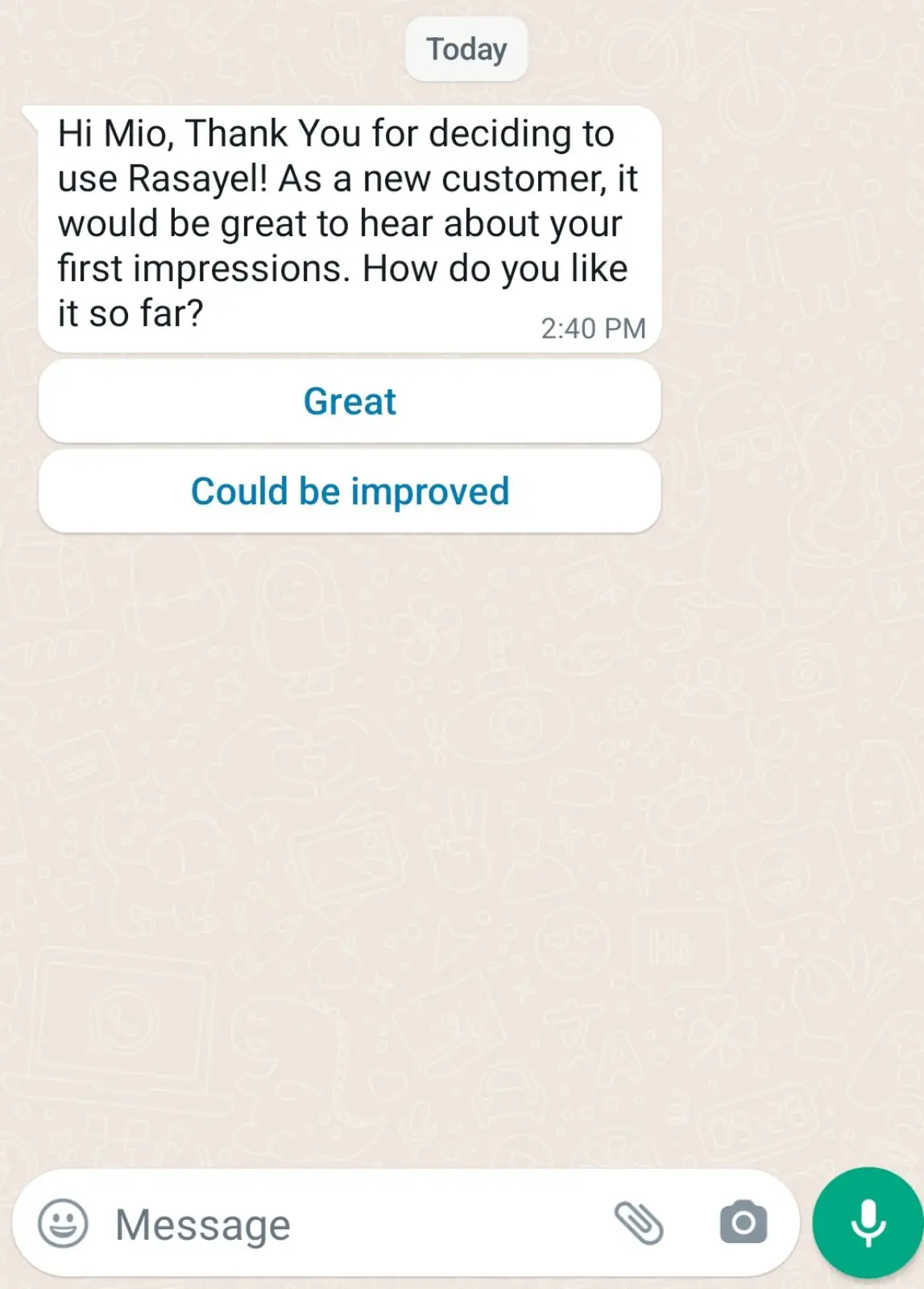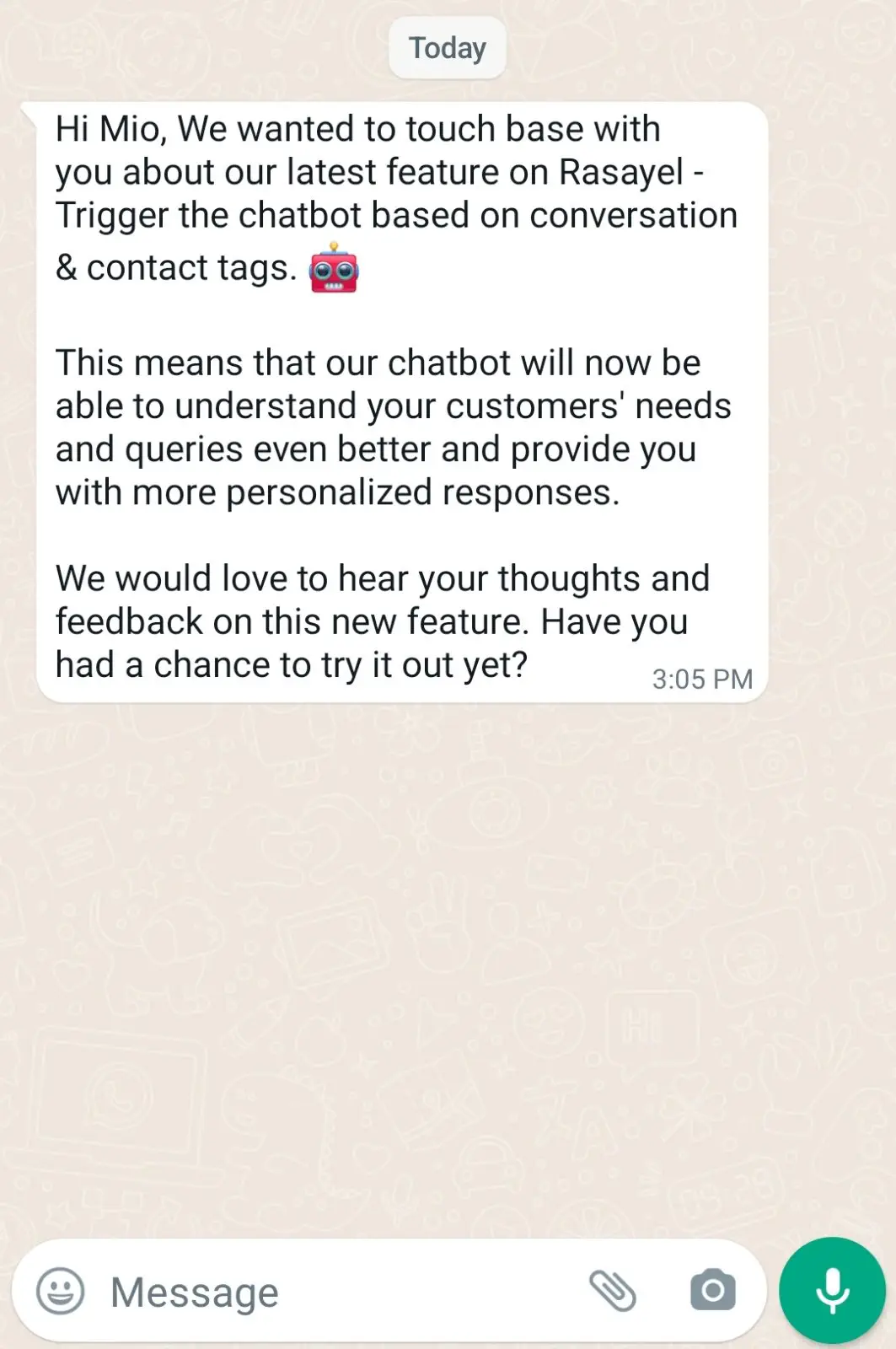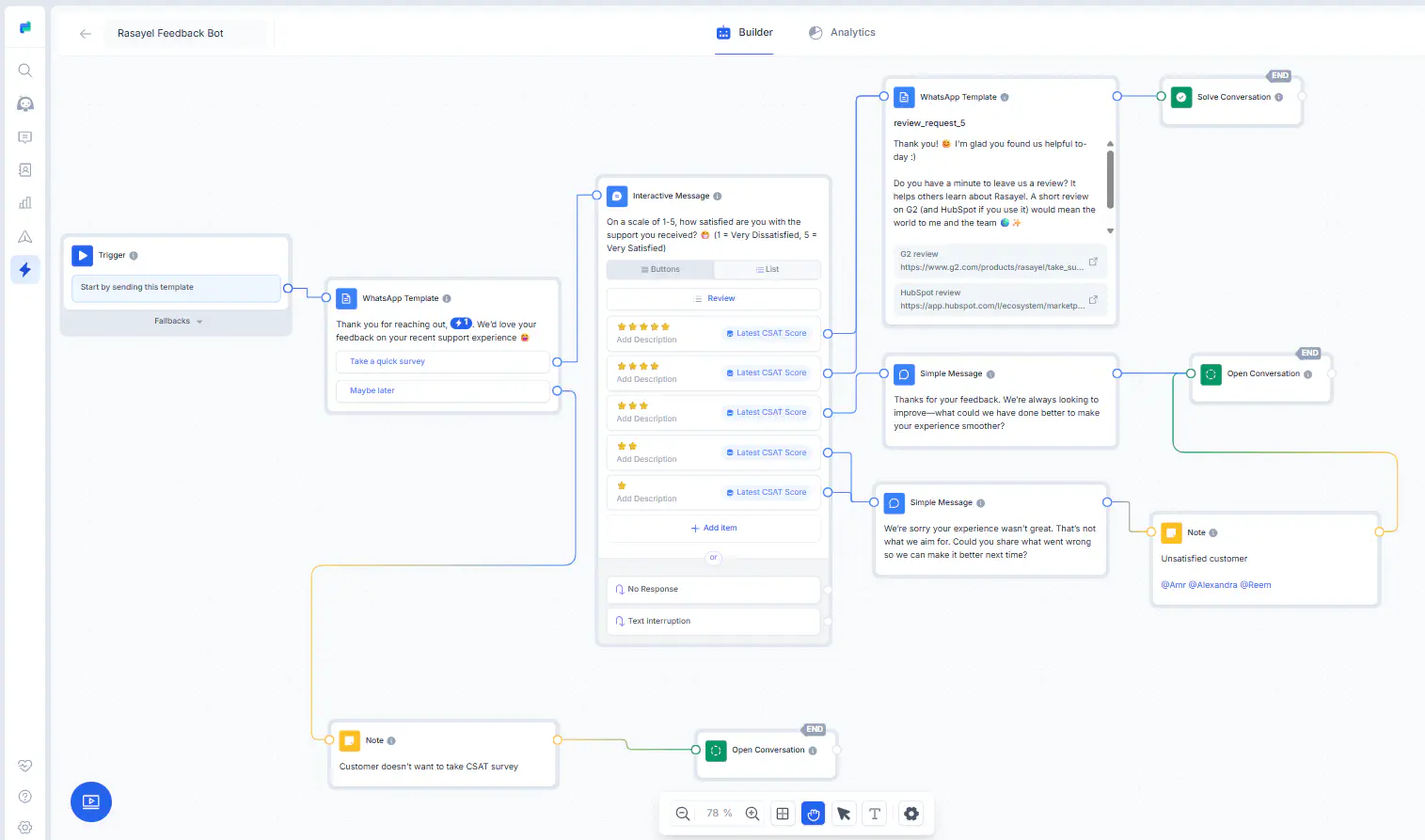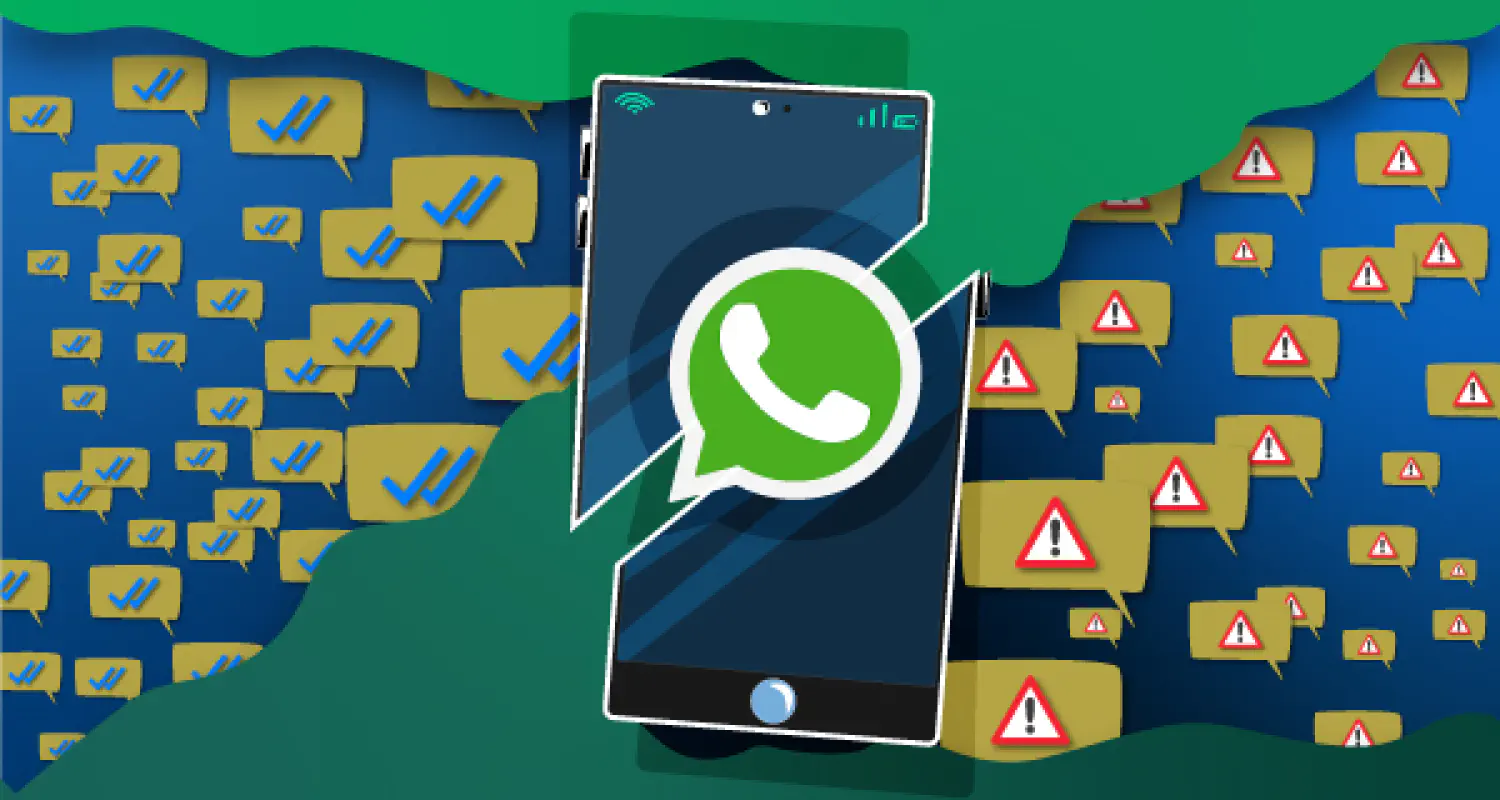How to Collect Customer Feedback on WhatsApp [5+ Methods]"
![How to Collect Customer Feedback on WhatsApp [5+ Methods]"](https://learn.rasayel.io/en/blog/whatsapp-customer-feedback/cover_hu8603427347192478022.webp)
Getting feedback isn’t easy. Trust us, we’ve tried. Most people don’t open survey emails, and even if they do, they rarely finish them. On the other hand, your customers are already on WhatsApp, asking questions, and getting support. So why not use it to collect the information you need to grow your business?
In this guide, we’ll walk you through how to use WhatsApp to gather customer feedback in a simple, effective way, based on what we’ve learned from using WhatsApp inside Rasayel.
When to ask customers for feedback on WhatsApp
Not every moment is the right time to ask for feedback. But if you choose the right one, customers are more likely to respond and give you answers you can actually use. Here are some of the best times to reach out.
Right after they become a customer
New customers can spot friction that long-time users overlook. Their first impressions help you improve onboarding, setup, and communication. Try asking something like this:
“Hi {{1}}, Thank you for deciding to use [your product or service]! As a new customer, it would be great to hear about your first impressions. How do you like it so far?”

After the customer has used the product
Once your customer has had some time with your product or service, it’s a good moment to check in. You’ll get more useful answers when they’ve had a chance to try things out.
Here is a message template you can use to ask for customer feedback:
“Hi {{1}}, how are you enjoying [your product or service] so far? We would love to hear about your experience so we can improve our services.”
If a customer leaves a review, consider using WhatsApp to respond and ask for their feedback. This is an excellent opportunity to show that you value their opinions and are committed to improving your products or services.
After they’ve been with you for a while
Long-term customers know your product inside out. Their feedback is especially valuable when you’re planning bigger improvements. Here’s a message you can send:
“Hi {{1}},
Thank you for using [your product]! We would love to get your feedback about your experience. Kindly rate your experience with us.
1 - Very satisfied
2 - Satisfied
3 - Neither agree nor disagree
4 - Dissatisfied
5 - Very dissatisfied”

After launching a new feature or update
Once you release something new, don’t wait too long to ask what people think. You’ll get fresh reactions and catch any confusion or issues early.
Here’s how you can ask:
“Hi {{1}},
We just rolled out an update to [your product], and we’d love your input. Have you tried it yet? What would you improve?”

After social media mentions
If a customer mentions your brand on social media, follow up with them on WhatsApp. It’s a good way to thank them and ask for deeper feedback. For this, you can send them a WhatsApp flow.
This helps you turn a public comment into a personal conversation and gives you clear input you can actually use.
Why use WhatsApp to gather contact details
Most businesses already use WhatsApp to talk to customers. So why not use it to learn from them, too? Here’s why WhatsApp is one of the best channels for collecting feedback.
Faster responses than email or forms
WhatsApp messages get read and replied to much faster than email or web forms. This is especially useful when you need quick answers during critical stages like onboarding or qualification. Instead of chasing people for follow-up, you can get data while they’re still engaged.
Higher trust and better data quality
Conversations on WhatsApp feel more personal and informal than traditional channels. When customers feel like they’re talking to a person instead of filling out a form, they’re more likely to give honest, accurate responses. This leads to better-quality data for your team to act on.
Works across the customer journey
WhatsApp lets you collect different pieces of information over time during onboarding, after product demos, or before renewal. This ongoing interaction feels like part of the conversation, not a data request.
Feeds directly into your CRM
If you’re using Rasayel, the data you collect over WhatsApp can sync directly into your CRM. You can automatically tag contacts based on their answers, update fields like lifecycle stage or interest, and trigger follow-ups without manual entry. This keeps your segments clean and always up to date.
How to get customer insights with WhatsApp
You can start with the basics. WhatsApp lets you send simple surveys directly in the app. It’s a good option if you just need a quick pulse check.
But if you’re collecting customer information at scale or want to automate it, you’ll need the WhatsApp Business Platform. It lets you use chatbots, message templates, and CRM integrations to scale your process and keep everything organized.
Here’s how to do it step by step:
1. Identify the type of feedback needed
Start by deciding what kind of feedback you’re looking for. Are you trying to improve a product? Understand why leads don’t convert? Measure customer satisfaction after a support interaction?
This will shape your questions, timing, and who you ask. If your goal is too broad, the answers won’t help much. Keep it specific and tied to a decision you need to make.
2. Create feedback templates and flows
Broadcasts let you send the same message to many customers at once. You can use them to run surveys, share new features, or ask for input. Before sending a template to multiple contacts, make sure all of them have opted in. Otherwise, they might report your message as spam.
You can create templates with interactive buttons to make it easy to respond. For example:
- “How satisfied are you with your recent support?”
- Very
- Neutral
- Not at all
- “Which feature should we improve next?”
- A
- B
- C
If you need to ask multiple questions or collect structured responses, use WhatsApp flows. You can create different flows for different moments, such as post-purchase feedback, churn reasons, or NPS surveys, and trigger them automatically based on what the customer just did.
3. Automate feedback collection with chatbots
Set up a simple chatbot to send questions, collect answers, and respond based on what people say.

You can also set it up to respond based on what the customer says, like routing a complaint to support or tagging a feature request.
4. Sync feedback data to CRM
Connect WhatsApp to your CRM so responses get logged under the right contact. That way, feedback doesn’t get lost in a chat.
You can tag contacts based on their answers (e.g., unhappy with onboarding, interested in a new feature), and add them to a follow-up list. This will let you filter by segment, so you can see how feedback changes by region, plan, or customer type.
It also helps your team follow up. For example, if someone gives negative feedback, a sales or support rep can step in to fix the issue.
5. Test and refine your feedback process
Before you send your proactive bot or broadcast to hundreds of people, run it with a small test group. Pick a sample that matches your target audience.
Pay attention to how many people open the message, how far they go, and where they drop off. Are the questions clear? Are the options too many or too vague? Are people stopping after question one?
Use that data to tweak the wording, order of questions, or response types. A small change (like making the first question easier) can boost completion rates.
6. Launch and monitor
Once everything works well, launch it to a larger audience. Don’t just set it and forget it, but track how people respond in real time.
Look at open rates, completion rates, and how answers vary across segments. If replies start dropping, pause and review what’s changed.
Make it part of your process to regularly review the feedback, tag useful insights, and share them with the right teams. If you’re not acting on what you collect, the whole thing becomes a waste of time for you and your customers.
Best practices for WhatsApp feedback outreach
Keep these tips in mind to get better feedback and make the most of your efforts.
- Keep it concise and relevant. Ask only what you need. Clear, simple questions get more responses. And better ones.
- Personalize your messages. Use the customer’s name and adjust the message to fit their situation. It shows you care and boosts response rates.
- Offer incentives. A small discount or gift can go a long way in getting people to share their thoughts.
- Analyze the feedback. Don’t just collect data. Review it, share it with your team, and use it to improve your product or service.
Conclusion
WhatsApp gives you a direct line to your customers. It’s fast, personal, and easy to use.
Use it to ask simple questions, collect insights, and improve your product based on what real customers say. With tools like chatbots, flows, and CRM integration, you can scale the process without losing the personal touch.
Start small, keep it clear, and most importantly, act on the feedback you get.
Frequently Asked Questions

Miodrag is a seasoned WhatsApp marketing expert with over 15 years of experience in B2B sales and communication. Specializing in the use of WhatsApp Business API, he helps businesses use WhatsApp’s marketing features to grow their sales and improve customer engagement. As one of the early adopters of WhatsApp Business, Miodrag has a deep understanding of its tools and strategies, making him a trusted authority in the field. His insights have helped many businesses with their communication strategies to achieve measurable results.




